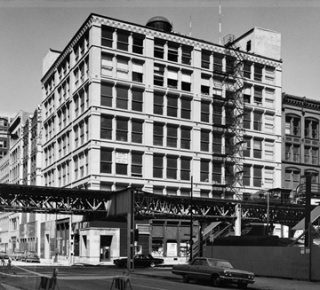Education | Timeline |
- 1829
- 1834
- 1840s
- 1848
- 1853
- 1859
- 1870
- 1870s
- 1871
- 1875
- 1877
- 1879
- 1880s
- 1882
- 1883
- 1884
- 1886
- 1887
- 1889
- 1890s
- 1891
- 1892
- 1893
- 1894
- 1895
- 1898
- 1899
- 1900
- 1900s
- 1901
- 1902
- 1904
- 1905
- 1906
- 1908
- 1909
- 1910
- 1910s
- 1911
- 1912
- 1913
- 1914
- 1915
- 1916
- 1917
- 1918
- 1919
- 1920
- 1920s
- 1921
- 1922
- 1923
- 1924
- 1925
- 1926
- 1927
- 1928
- 1929
- 1930s
- 1930
- 1931
- 1933
- 1934
- 1935
- 1936
- 1937
- 1938
- 1939
- 1940s
- 1940
- 1941
- 1942
- 1943
- 1944
- 1945
- 1946
- 1947
- 1948
- 1949
- 1950s
- 1950
- 1951
- 1952
- 1953
- 1954
- 1955
- 1956
- 1957
- 1958
- 1959
- 1960s
- 1960
- 1961
- 1962
- 1963
- 1964
- 1965
- 1966
- 1967
- 1968
- 1969
- 1970s
- 1970
- 1971
- 1972
- 1973
- 1974
- 1976
- 1979
- 1980
- 1992
Leiter I Building, Chicago
According to Historic American Building Survey, the first Leiter Building, built 1879, is a Chicago Architectural Landmark. William LeBaron Jenney is the architect. The building is a landmark because it contributed to the development of skeleton construction. Constructed of cast iron pilasters from the foundation to the roof, the building could be built taller. Jenney's skeleton construction, replacing stone and brick, is an important engineering advance that leads to skyscrapers.







Edison Invents the Light Bulb
In 1875 Thomas A. Edison establishes an experimental laboratory in Menlo Park, New Jersey. He envisions the laboratory as a facility dedicated to pure invention. Menlo Park is one of the first modern industrial research labs. An early interest is the incandescent light bulb.
Edison envisions economical/practical electrical lighting to improve the everyday lives of Americans. He believes the key is an efficient incandescent lamp. Incandescent lamps make light by heating a filament (thin strip of material) until it glows. From 1878 to 1880 Edison and his team conduct 3000 experiments to learn how to make this lamp. In 1879 Edison succeeds by inventing his first high resistance, incandescent electric light. Made of a thin platinum filament, mounted in a glass vacuum, the bulb produces light, but only for a short time. Edison continues to experiment with thousands of different substances until he finds a suitable, durable material to use for the filament. Patent number 223,898 is given to his successful electric lamp.
By the 1930s the U.S. Government purchases an average of 4,000,000 light bulbs a year for use in government buildings. In this photograph the National Bureau of Standards does a variety of quality tests to determine the amount of light lamps provide and how long they last.